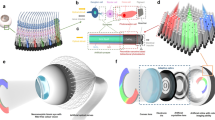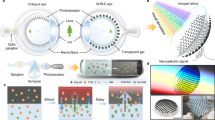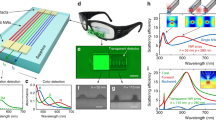Abstract
Human eyes possess exceptional image-sensing characteristics such as an extremely wide field of view, high resolution and sensitivity with low aberration1. Biomimetic eyes with such characteristics are highly desirable, especially in robotics and visual prostheses. However, the spherical shape and the retina of the biological eye pose an enormous fabrication challenge for biomimetic devices2,3. Here we present an electrochemical eye with a hemispherical retina made of a high-density array of nanowires mimicking the photoreceptors on a human retina. The device design has a high degree of structural similarity to a human eye with the potential to achieve high imaging resolution when individual nanowires are electrically addressed. Additionally, we demonstrate the image-sensing function of our biomimetic device by reconstructing the optical patterns projected onto the device. This work may lead to biomimetic photosensing devices that could find use in a wide spectrum of technological applications.
This is a preview of subscription content, access via your institution
Access options
Access Nature and 54 other Nature Portfolio journals
Get Nature+, our best-value online-access subscription
$29.99 / 30 days
cancel any time
Subscribe to this journal
Receive 51 print issues and online access
$199.00 per year
only $3.90 per issue
Buy this article
- Purchase on Springer Link
- Instant access to full article PDF
Prices may be subject to local taxes which are calculated during checkout




Similar content being viewed by others
Data availability
The data that support the findings of this study are provided in the main text and the Supplementary Information. More data are available from the corresponding author upon reasonable request.
References
Atchison, D. A. & Smith, G. Optics of the Human Eye Vol. 35 (Butterworth-Heinemann, 2000).
Zhang, J., Con, C. & Cui, B. Electron beam lithography on irregular surfaces using an evaporated resist. ACS Nano 8, 3483–3489 (2014).
Qin, D., Xia, Y. & Whitesides, G. M. Soft lithography for micro-and nanoscale patterning. Nat. Protocols 5, 491–502 (2010).
Pocock, D. C. D. Sight and knowledge. Trans. Inst. Br. Geogr. 6, 385–393 (1981).
Jung, I. et al. Dynamically tunable hemispherical electronic eye camera system with adjustable zoom capability. Proc. Natl Acad. Sci. USA 108, 1788–1793 (2011).
Nassi, J. J. & Callaway, E. M. Parallel processing strategies of the primate visual system. Nat. Rev. Neurosci. 10, 360–372 (2009).
Jonas, J. B., Schneider, U. & Naumann, G. O. Count and density of human retinal photoreceptors. Graefes Arch. Clin. Exp. Ophthalmol. 230, 505–510 (1992).
Gu, L. et al. 3D arrays of 1024-pixel image sensors based on lead halide perovskite nanowires. Adv. Mater. 28, 9713–9721 (2016).
Gu, L. et al. Significantly improved black phase stability of FAPbI3 nanowires via spatially confined vapor phase growth in nanoporous templates. Nanoscale 10, 15164–15172 (2018).
Waleed, A. et al. Lead-free perovskite nanowire array photodetectors with drastically improved stability in nanoengineering templates. Nano Lett. 17, 523–530 (2017).
Schein, S. J. Anatomy of macaque fovea and spatial densities of neurons in foveal representation. J. Comp. Neurol. 269, 479–505 (1988).
Dickey, M. D. et al. Eutectic gallium-indium (EGaIn): a liquid metal alloy for the formation of stable structures in microchannels at room temperature. Adv. Funct. Mater. 18, 1097–1104 (2008).
Song, Y. M. et al. Digital cameras with designs inspired by the arthropod eye. Nature 497, 95–99 (2013).
Ko, H. C., Stoykovich, M. P., Song, J., Malyarchuk, V. & Rogers, J. A. A hemispherical electronic eye camera based on compressible silicon optoelectronics. Nature 454, 748–753 (2008).
Zhang, K. et al. Origami silicon optoelectronics for hemispherical electronic eye systems. Nat. Commun. 8, 1782 (2017).
Han, Q. et al. Single crystal formamidinium lead iodide (FAPbI3): insight into the structural, optical, and electrical properties. Adv. Mater. 28, 2253–2258 (2016).
Fan, Z. et al. Ordered arrays of dual-diameter nanopillars for maximized optical absorption. Nano Lett. 10, 3823–3827 (2010).
Fan, Z. et al. Three-dimensional nanopillar-array photovoltaics on low-cost and flexible substrates. Nat. Mater. 8, 648–653 (2009).
Ramdani, M. R. et al. Fast growth synthesis of GaAs nanowires with exceptional length. Nano Lett. 10, 1836–1841 (2010).
Wen, C. Y. et al. Formation of compositionally abrupt axial heterojunctions in silicon-germanium nanowires. Science 326, 1247–1250 (2009).
Wandell, B. A. Foundations of Vision Vol. 8 (Sinauer Associates, 1995).
Boschloo, G. & Hagfeldt, A. Characteristics of the iodide/triiodide redox mediator in dye-sensitized solar cells. Acc. Chem. Res. 42, 1819–1826 (2009).
Kawano, R. & Watanabe, M. Equilibrium potentials and charge transport of an I-/I3 - redox couple in an ionic liquid. Chem. Commun. 3, 330–331 (2003).
Rayner, K., Smith, T. J., Malcolm, G. L. & Henderson, J. M. Eye movements and visual encoding during scene perception. Psychol. Sci. 20, 6–10 (2009).
Mustafi, D., Engel, A. H. & Palczewski, K. Structure of cone photoreceptors. Prog. Retin. Eye Res. 28, 289–302 (2009).
Fujikado, T. et al. Evaluation of phosphenes elicited by extraocular stimulation in normals and by suprachoroidal-transretinal stimulation in patients with retinitis pigmentosa. Graefes Arch. Clin. Exp. Ophthalmol. 245, 1411–1419 (2007).
Ayton, L. N. et al. First-in-human trial of a novel suprachoroidal retinal prosthesis. PLoS One 9, e115239 (2014).
Shivdasani, M. N. et al. Factors affecting perceptual thresholds in a suprachoroidal retinal prosthesis. Invest. Ophthalmol. Vis. Sci. 55, 6467–6481 (2014).
Navarro, R. The optical design of the human eye: a critical review. J. Optom. 2, 3–18 (2009).
Acknowledgements
This work was supported by the National Natural Science Foundation of China (project 51672231) and the Science and Technology Plan of Shenzhen (JCYJ20170818114107730), the General Research Fund (projects 16237816, 16309018 and 16214619) from the Hong Kong Research Grant Council, Hong Kong Innovation Technology Commission (project ITS/115/18) and The Hong Kong University of Science and Technology (HKUST) Fund of Nanhai (grant number FSNH-18FYTRI01). We acknowledge support received from the Material Characterization and Preparation Facility (MCPF, particularly Y. Cai for her technical assistance with the focused ion beam), the Nanosystem Fabrication Facility (NFF), the Center for 1D/2D Quantum Materials and the State Key Laboratory on Advanced Displays and Optoelectronics at HKUST. We also thank D. Wang (Chemistry Department, Boston College), M. Shao (Department of Chemical and Biological Engineering, HKUST) and Q. Chen (Department of Mechanical and Aerospace Engineering, HKUST) for their discussions on the electrochemical impedance spectroscopy measurements. The images in Fig. 1a–d and Supplementary Fig. 1 were created by Fantastic Color Animation Technology Co., Ltd (2020).
Author information
Authors and Affiliations
Contributions
Z.F. and L.G. conceived the ideas of the work. L.G., Z.L., D.Z., Q.Z. and L.S. contributed to PAM fabrication, perovskite and Ni nanowire growth. S.P. contributed to the focused-ion-beam process. Y.L. developed the photoelectrochemical working mechanism. L.G., Z.L. and X.Q. worked on Ni microneedle assembly and EC-EYE device characterizations. L.G., Y.L., M.K., A.J. and Z.F. carried out the data analysis and wrote the manuscript. All authors discussed the results and commented on the manuscript.
Corresponding author
Ethics declarations
Competing interests
The authors declare no competing interests.
Additional information
Peer review information Nature thanks Dae-Hyeong Kim, Hongrui Jiang and the other, anonymous, reviewer(s) for their contribution to the peer review of this work.
Publisher’s note Springer Nature remains neutral with regard to jurisdictional claims in published maps and institutional affiliations.
Supplementary information
Supplementary Information
Supplementary Methods, Discussions and Table. This file contains Supplementary Sections 1-27. It includes more details on preparation and characterization of perovskite NWs, the device assembly, mechanism discussion and image sensing characterization of individual and arrayed NWs based photodetectors, hemispherical EC-EYEs and integrated EC image sensors.
Supplementary Video
The dynamic process of EC-EYE capturing letters character patterns.
Rights and permissions
About this article
Cite this article
Gu, L., Poddar, S., Lin, Y. et al. A biomimetic eye with a hemispherical perovskite nanowire array retina. Nature 581, 278–282 (2020). https://doi.org/10.1038/s41586-020-2285-x
Received:
Accepted:
Published:
Issue Date:
DOI: https://doi.org/10.1038/s41586-020-2285-x
This article is cited by
-
Differential perovskite hemispherical photodetector for intelligent imaging and location tracking
Nature Communications (2024)
-
Strain-insensitive viscoelastic perovskite film for intrinsically stretchable neuromorphic vision-adaptive transistors
Nature Communications (2024)
-
A bionic self-driven retinomorphic eye with ionogel photosynaptic retina
Nature Communications (2024)
-
Recent advances in bioinspired vision systems with curved imaging structures
Rare Metals (2024)
-
Artificial Intelligence Meets Flexible Sensors: Emerging Smart Flexible Sensing Systems Driven by Machine Learning and Artificial Synapses
Nano-Micro Letters (2024)
Comments
By submitting a comment you agree to abide by our Terms and Community Guidelines. If you find something abusive or that does not comply with our terms or guidelines please flag it as inappropriate.



